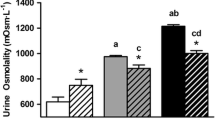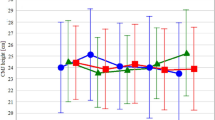Abstract
This study examined vertical jump performance using a force platform and weighted vest to determine why hypohydration (~4% body mass) does not improve jump height. Measures of functional performance from a force platform were determined for 15 healthy and active males when euhydrated (EUH), hypohydrated (HYP) and hypohydrated while wearing a weighted vest (HYPv) adjusted to precisely match water mass losses. HYP produced a significant loss of body mass [−3.2 ± 0.5 kg (−3.8 ± 0.6%); P < 0.05], but body mass in HYPv was not different from EUH. There were no differences in absolute or relative peak force or power among trials. Jump height was not different between EUH (0.380 ± 0.048 m) and HYP (0.384 ± 0.050 m), but was 4% lower (P < 0.05) in HYPv (0.365 ± 0.52 m) than EUH due to a lower jump velocity between HYPv and EUH only (P < 0.05). However, vertical ground reaction impulse (VGRI) was reduced in both HYP and HYPv (2–3%) compared with EUH (P < 0.05). In conclusion, this study demonstrates the failure to improve jump height when HYP can be explained by offsetting reductions in both VGRI and body mass.


Similar content being viewed by others
Notes
Assumes work (force × distance) is unchanged by hypohydration, rather than impulse (force × time) (Viitasalo et al. 1987), since a lighter body mass would be accelerated faster if force remained constant, thereby reducing impulse by shortening the time of force application. As a result, the level of hypohydration (e.g., 4%) is equivalent to the theoretical percent improvement in jump height. [Note: If impulse remained constant, the denominator of the equation above would become squared and the theoretical improvement would be double the level of hypohydration (e.g., 8%).]
References
Aagaard P, Simonsen EB, Andersen JL, Magnusson P, Dyhre-Poulsen P (2002) Increased rate of force development and neural drive of human skeletal muscle following resistance training. J Appl Physiol 93:1318–1326
Armstrong LE, Herrera Soto JA, Hacker FT, Casa DJ, Kavouras SA, Maresh CM (1998) Urinary indices during dehydration, exercise, and rehydration. Int J Sports Nutr 8:345–355
Batterham AM, Hopkins WG (2005) Making meaningful inferences about magnitudes. Sportscience 9:6–13
Bennett AF (1984) Thermal dependence on muscle function. Am J Physiol Regul Integr Comp Physiol 247(16):R217–R229
Bigard AX, Sanchez H, Claveyrolas G, Martin S, Thimonier B, Arnaud MJ (2001) Effects of dehydration and rehydration on EMG changes during fatiguing contractions. Med Sci Sports Exerc 33(10):1694–1700
Bosco C, Luhtanen P, Komi PV (1983) A simple method for measurement of mechanical power in jumping. Eur J Appl Physiol 50:273–282
Boulant JA, Silva NL (1988) Neuronal sensitivities in preoptic tissue slices: Interactions among homeostatic systems. Brain Res Bull 20(6):871–878
Cheuvront SN, Carter R, Montain SJ, Sawka MN (2004) Daily body mass variability and stability in active men undergoing exercise-heat stress. Int J Sport Nutr Exerc Metab 14:532–540
Cheuvront SN, Carter R, Castellani JW, Sawka MN (2005) Hypohydration impairs endurance exercise performance in temperate but not cold air. J Appl Physiol 99:1972–1976
Cheuvront SN, Carter R, Haymes EM, Sawka MN (2006) No effect of moderate hypohydration or hyperthermia on anaerobic exercise performance. Med Sci Sports Exerc 38(6):1093–1097
Chicharro JL, Lopez-Mojares LM, Lucia A, Alvarez J, Calvo F, Vaquero AF (1998) Overtraining parameter in special military units. Aviat Space Environ Med 69:562–568
Cordova ML, Armstrong CW (1996) Reliability of ground reaction forces during a vertical jump: implications for functional strength assessment. J Athl Train 31(4):342–345
Costill DL, Cote R, Fink W (1976) Muscle water and electrolytes following varied levels of dehydration in man. J Appl Physiol 40(1):6–11
Curran-Everett D, Benos DJ (2004) Guidelines for reporting statistics in journals published by the American Physiological Society. Am J Physiol Regul Integr Comp Physiol 287:R247–R249
Ebbutt AF, Frith L (1998) Practical issues in equivalence trials. Statist Med 17:1691–1701
Enoka RM, Stuart DG (1992) Neurobiology of muscle fatigue. J Appl Physiol 72(5):1631–1648
Evetovich TK, Boyd JC, Drake SM, Eschbach LC, Magal M, Soukup JT, Webster MJ, Whitehead MT, Weir JP (2002) Effect of moderate dehydration on torque, electromyography, and mechanomyography. Muscle Nerve 26:225–231
Feig PU, McCurdy DK (1977) The hypertonic state. N Eng J Med 297(26):1444–1454
Fogelholm M (1994) Effects of bodyweight reduction on sports performance. Sports Med 18(4):249–267
Fogelholm GM, Koskinen R, Laakso J, Rankinen T, Ruokonen I (1993) Gradual and rapid weight loss: effects on nutrition and performance in male athletes. Med Sci Sports Exerc 25(3):371–377
Frykman PN, Seay JF, Catrambone DE, Sharp MA (2009) Simultaneous comparison of power output from three methods of vertical jump tests. Med Sci Sports Exerc 41(5 Suppl):S191–S192
Gandevia SC (2001) Spinal and supraspinal factors in human muscle fatigue. Physiol Rev 81(4):1725–1789
Gutierrez A, Mesa JLM, Ruiz JR, Chirosa LJ, Castillo MJ (2003) Sauna-induced rapid weight loss decreases explosive power in women but not in men. Int J Sports Med 24:518–522
Hakkinen K, Alen M, Komi PV (1984) Neuromuscular, anaerobic, and aerobic performance characteristics of elite power athletes. Eur J Appl Physiol 53:97–105
Harman EA (1994) The biomechanics of resistance exercise. In: Baechle TR (ed) Essentials of strength training and conditioning. Human Kinetics, Champaign
Harman EA, Rosenstein MT, Frykman PN, Rosenstein RM (1990) The effects of arms and countermovement on vertical jump. Med Sci Sports Exerc 22(6):825–833
Hayes LD and Morse CI (2009) The effects of progressive dehydration on strength and power: is there a dose response? Eur J Appl Physiol (Epub ahead of print)
Hoffman JR, Stavsky H, Falk B (1995) The effect of water restriction on anaerobic power and vertical jumping height in basketball players. Int J Sports Med 16:214–218
Hopkins WG (2004) How to interpret changes in an athletic performance test. Sportscience 8:1–7
Hopkins WG, Hawley JA, Burke LM (1999) Design and analysis of research on sport performance enhancement. Med Sci Sports Exerc 31(3):472–485
Jackson AS, Pollock ML (1978) Generalized equations for predicting body density of men. Br J Nutr 40:497–504
Judelson DA, Maresh CM, Anderson JM, Armstong LE, Casa DJ, Kraemer WJ, Volek JS (2007a) Hydration and muscular performance: does fluid balance affect strength, power, and high-intensity endurance? Sports Med 37(10):907–921
Judelson DA, Maresh CM, Farrell MJ, Yamamoto LM, Armstrong LE, Kraemer WJ, Volek JS, Spiering BA, Casa DJ, Anderson JM (2007b) Effect of hydration state on strength, power, and resistance exercise performance. Med Sci Sports Exerc 39(10):1817–1824
Kraemer WJ, Fry AC, Rubin MR, Triplett-McBride T, Gordon SE, Koziris LP, Lynch JM, Volek JS, Meuffels DE, Newton RU, Fleck SJ (2001) Physiological and performance responses to tournament wrestling. Med Sci Sports Exerc 33(8):1367–1378
Lipsey MW (1990) Design sensitivity: statistical power for experimental research. Sage Publications, Newbury Park
Montain SJ, Smith SA, Mattot RP, Zientara GP, Jolesz FA, Sawka MN (1998) Hypohydration effects on skeletal muscle performance and metabolism: a 31P-MRS study. J Appl Physiol 84(6):1889–1894
Nakagawa S, Cuthill IC (2007) Effect size, confidence intervals and statistical significance: a practical guide for biologists. Biol Rev 82:591–605
Nindl BC, Leone CD, Tharion WJ, Johnson RF, Castellani JW, Patton JF, Montain SJ (2002) Physical performance responses during 72 h of military operational stress. Med Sci Sports Exerc 34(11):1814–1822
Rapoport SL (2000) Osmotic opening of the blood–brain barrier: principles, mechanism, and therapeutic applications. Cell Mol Neurobiol 20(2):217–230
Reichardt CS, Gollob HF (1997) When confidence intervals should be used instead of statistical tests, and vice versa. In: Harlow LL, Mulaik SA, Steiger JH (eds) What if there were no significance tests?. Erlbaum, Mahwah, NJ
Sawka MN, Burke LM, Eichner ER, Maughan RJ, Montain SJ, Stachenfeld NS (2007) American College of Sports Medicine position stand. Exercise and fluid replacement. Med Sci Sports Exerc 39(2):377–390
Thorstensson A, Karlsson J, Viitasalo HT, Luhtanen P, Komi PV (1976) Effect of strength training on EMG of human skeletal muscle. Acta Physiol Scand 98:232–236
Viitasalo JT, Kyrolainen H, Bosco C, Alen M (1987) Effects of rapid weight reduction on force production and vertical jumping height. Int J Sports Med 8(4):281–285
Watson G, Judelson DA, Armstrong LE, Yeargin SW, Casa DJ, Maresh CM (2005) Influence of diuretic-induced dehydration on competitive sprint and power performance. Med Sci Sports Exerc 37(7):1168–1174
Welsh TT, Alemany JA, Montain SJ, Frykman PN, Tuckow AP, Young AJ, Nindl BC (2008) Effects of intensified military field training on jumping performance. Int J Sports Med 29:45–52
Williams MH (1998) Rating the sports ergogenics. The ergogenics edge: pushing the limits of sports performance. Human Kinetics, Champaign, IL
Acknowledgments
The authors would like to thank all the volunteers who participated in this study. The authors are grateful for the assistance provided by Laura J. Palombo and SGT Daniel E. Catrambone. We would also like to thank Dr. Scott J. Montain for reading and remarking on this manuscript. The opinions or assertions contained herein are the private views of the author(s) and are not to be construed as official or as reflecting the views of the Army or the Department of Defense.
Author information
Authors and Affiliations
Corresponding author
Additional information
Communicated by Jean-René Lacour.
Appendix
Appendix
Summary of calculation for theoretical jump heightFootnote 1 improvement with hypohydration:
where
Rights and permissions
About this article
Cite this article
Cheuvront, S.N., Kenefick, R.W., Ely, B.R. et al. Hypohydration reduces vertical ground reaction impulse but not jump height. Eur J Appl Physiol 109, 1163–1170 (2010). https://doi.org/10.1007/s00421-010-1458-y
Accepted:
Published:
Issue Date:
DOI: https://doi.org/10.1007/s00421-010-1458-y




